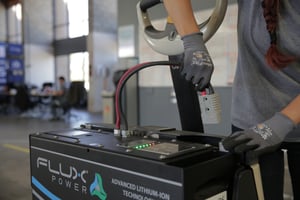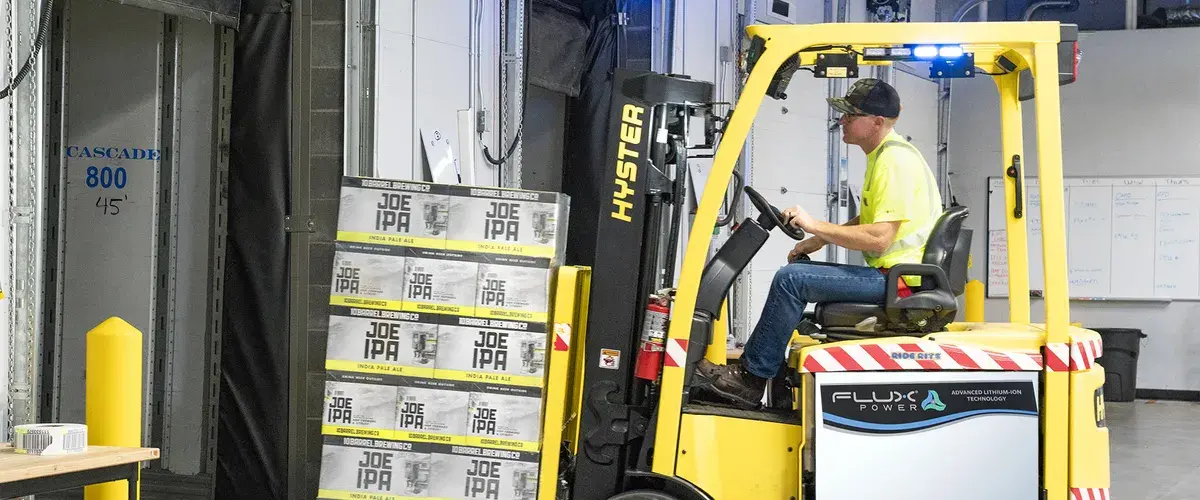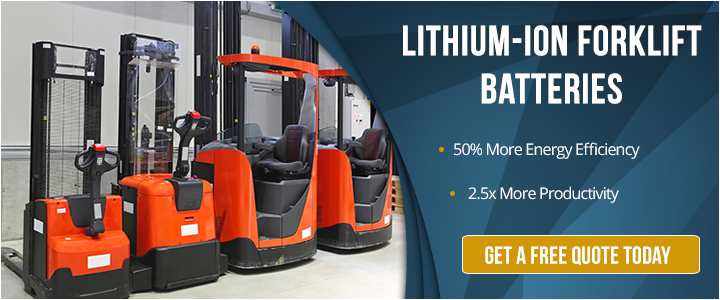Though “lithium-ion battery” is typically used as a general, all-encompassing term, there are actually at least a dozen different lithium-based chemistries that make up these rechargeable batteries.
Some of the most common types include:
- Lithium iron phosphate (LFP)
- Lithium nickel manganese cobalt oxide (NMC)
- Lithium cobalt oxide (LCO)
- Lithium manganese oxide (LMO)
- Lithium nickel cobalt aluminum oxide (NCA)
- Lithium titanate (LTO)
However, material handling equipment is typically powered by either lithium iron phosphate or lithium nickel manganese cobalt oxide chemistries.
Below we’ll explore these chemistries and how they play a role in making lithium-ion batteries one of the most popular choices of power for material handling equipment.
Lithium Iron Phosphate (LiFePO4)
 Lithium iron phosphate is more compact and energy dense, making it an excellent choice for us in material handling applications, such as powering equipment like electric forklifts, walkie pallet jacks, and end riders.
Lithium iron phosphate is more compact and energy dense, making it an excellent choice for us in material handling applications, such as powering equipment like electric forklifts, walkie pallet jacks, and end riders.
When you plug a lithium-ion battery into a device or piece of equipment, the positively-charged ions move from the anode to the cathode. The anode stores the lithium and is typically made from carbon. The cathode also stores the lithium and is made from a chemical compound that is a metal oxide.
In batteries with lithium iron phosphate chemistry, phosphate serves as the cathode material. As a result, the cathode becomes more positively charged than the anode. This, in turn, attracts negatively-charged electrons to the cathode.
A separator in the cell includes electrolytes that form a catalyst. This promotes ion movement from the cathode to the anode and back. As the electrons begin working their way toward the cathode, the battery system is designed to force them to go through the device and use that energy to generate power.
Lithium-ion batteries are rechargeable. When recharging, the lithium-ions go through the same process, but in the opposite direction. This restores the battery for additional use.
A battery with lithium iron phosphate chemistry offers high performance and low resistance, and enjoys a longer life cycle, greater thermal stability and enhanced safety.
Lithium iron phosphate batteries are also more tolerant to being fully charged and don’t experience as much stress as other types of lithium-ion chemistries when they endure prolonged high voltages.
Lithium Nickel Manganese Cobalt Oxide (NMC)
Lithium nickel manganese cobalt oxide chemistries are very energy dense, which means they provide a higher level of performance, if the equipment is designed to support it. The high charge and discharge rates make it a more popular choice for electric vehicles, such as e-bikes, buses, cordless power tools and other electric power trains.
But a high discharge rate is only beneficial if you plan to use the equipment for shorter periods of time. Since most material handling equipment is used for an entire 8 to 10-hour shift, or even multiple shifts, the improved performance does not offer a benefit.
This type of battery chemistry uses a combination of nickel, manganese and cobalt for the cathode. Though the inclusion of nickel gives the cell high-specific energy, this also reduces its stability.
The inclusion of manganese, on the other hand, offers low internal resistance, but also features low specific energy. Combined, however, the chemistries work together to make this type of battery a suitable choice for certain types of equipment. The increased performance comes at a price…lithium nickel manganese cobalt oxide batteries have a lower thermal runaway temperature, meaning they are less safe than LFP.
Overall Benefits
The chemistry of lithium-ion batteries offer several benefits over their counterparts...lead acid batteries. These benefits directly impact the performance of your operations, providing a more efficient and safer workspace.
 Enhanced Safety
Enhanced Safety
Because the battery pack in a lithium-ion battery is completely sealed in design, there is no risk of spills. Unlike lead acid batteries, a lithium-ion battery’s design also does not require a “watering process” to keep fluid levels at a certain minimum. This watering process, necessary for lead-acid, can be a dangerous procedure if not performed correctly.
Opportunity Charging
A typical charge or use cycle for a lithium-ion battery is 7.2 hours of use, 1 to 2 hours to charge and another 7.2 hours of use. This allows crews to opportunity charge when on break or in between shifts. However, lead-acid batteries run only about 5.4 hours before requiring a charge, and then require another 8 hours to charge and 8 hours to cool down before the battery can be used again.
Longer Lifespans
Lithium-ion and lead acid batteries offer different lifespans. Lithium-ion batteries last between 2,000 and 3,000 cycles, whereas lead acid batteries typically only last between 1,000 and 1,500 cycles.
Maintenance Free
The design of a lithium-ion battery reduces the amount of time workers must dedicate for maintenance. In addition to not requiring watering maintenance, lithium-ion batteries also have battery management systems that perform cell balancing to keep the battery at a healthy state of charge.
Safe Discharge
A lithium-ion battery’s chemistry allows the battery to be safely discharged down to a 20% capacity. However, lead-acid batteries can only be safely discharged down to 30% to 50% capacity.
Temperature Resiliency
Lithium-ion batteries are extremely resilient to high and low temperatures. Lithium iron phosphate, the chemistry used by Flux Power, is especially resilient. Optional heaters also allow you to safely use these battery packs in cold temperatures.
You can read more about the lithium-ion battery benefits in our article, Lithium-ion vs Lead acid Forklift Batteries: Which Are Best?
Bottom Line
Lithium-ion batteries are rapidly becoming a go-to source of power for forklifts in many industries.
In particular, material handling operations are utilizing lithium iron phosphate chemistries to improve performance and enhance safety.












